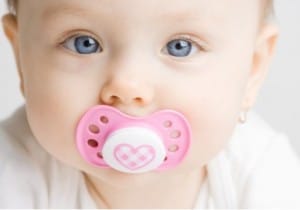
Concerns about pacifiers include the increased chances of middle ear infections and the potentially damaging effects in can have on breastfeeding efforts. Experts say, however, that both issues can be reduced or curbed altogether if parents know a few important points.
To prevent breastfeeding problems, AAP recommends that parents wait to offer a pacifier until three to four weeks after birth. This gives mother and baby the opportunity to get used to breastfeeding but still reduces the risk of SIDs in the most crucial time.
To avoid middle ear infections, parents should wash pacifiers regularly and replace them when they are damaged. Parents should also know that the risk of middle ear infections is highest after six months of age while the risk of SIDS is highest before six months of age.
Other tips for using a pacifier safely include:
- Not using a pacifier when baby needs to be fed.
- Not forcing baby to use a pacifier if they don’t want it.
- Not using any kind of sweet solutions or coatings on pacifiers to encourage use.
- Purchasing only the correct size of pacifier.
- Purchasing one-piece pacifiers that have a mouth shield of at least 1 ½ inches across.
- Only using a pacifier in the dishwasher if it is deemed dishwasher safe.
- Inspecting the pacifier often for discoloration, rips or cracks and replacing them if they show any signs of wear or tear.
Still a little uneasy about your decision? Then you should also be aware that non-feeding sucking is a very normal need for infants – one that they often try to satisfy, even if you don’t use a pacifier. The most commonly used sucking tool besides the pacifier is the finger or thumb.
Experts say that breaking a child from the pacifier is easier than breaking them from finger or thumb sucking, which often continues on into the elementary years. This can lead to both dental problems and social problems, if continued long enough.
If you’re still unsure, you can talk to your family doctor about the use of pacifiers and their advantages and disadvantages, but in the end, you have to decide what will work best for your family.
Related Articles:
- Rachel Stevens Talks Parenting & Sleepless Nights
- The Age Old Question – Are Breastfed Babies Smarter
- Would You Buy Your Child a Doll That Sounds Like It’s Swearing?






